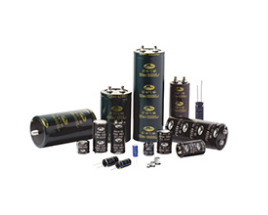选择适合的电解电容要根据使用场景来选择电解电容的电压、容量、使用寿命等多个参数来综合考虑,那么电解电容的不同参数分别代表什么含义呢?
The selection of suitable electrolytic capacitor should be based on the use scenario. The voltage, capacity, service life and other parameters of electrolytic capacitor should be comprehensively considered. What do the different parameters of electrolytic capacitor mean?

(1)额定电压 VR:是设计电容时设计的而且表示在电容上的直流电压。对于铝 电解电容,额定电压≤100 V 通常叫做低压电容,而额定电压>100 V 称作(中)高 压电容,常用的额定电压有 6.3V,10V,16V,25V,50V,63V,100V,250V, 400V,450V,500V,630V 等。
Rated voltage VR: it is designed when designing the capacitor and represents the DC voltage on the capacitor. For aluminum electrolytic capacitors, the rated voltage ≤ 100 V is usually called low-voltage capacitor, while the rated voltage > 100 V is called (medium) high-voltage capacitor. The commonly used rated voltages are 6.3V, 10V, 16V, 25V, 50V, 63v, 100V, 250V, 400V, 450V, 500V, 630V, etc.
(2)工作电压VOP:电容可以在额定电压(包含一些叠加成份)下额定工作范 围内连续工作。允许的连续工作电压范围为0V到额定电压之间。在很短时间内, 因阴极铝箔上有一层空气氧化层,电容可以承受不超过1.5 V 的反向电压。
Working voltage VOP: the capacitor can work continuously within the rated working range under the rated voltage (including some superimposed components). The allowable continuous working voltage range is between 0V and rated voltage. In a very short time, because there is an air oxide layer on the cathode aluminum foil, the capacitor can withstand a reverse voltage of no more than 1.5 v.
(3)浪涌电压VS:是短时间内可以加在电容上的最大电压,比如一小时内5次, 每次一分钟。IEC 60384-4定义浪涌电压如下:如果 VR ≤ 315 V,VS = 1.15VR, 如果VR > 315 V,VS = 1.10VR。
Surge voltage vs: the maximum voltage that can be applied to the capacitor in a short time, for example, five times in an hour, one minute each time. IEC 60384-4 defines the surge voltage as follows: if VR ≤ 315 V, vs = 1.15vr; if VR > 315 V, vs = 1.10vr.
(4)额定容量CR:是电容设计和标示的交流电容值。CR是由(IEC 60384-1 and IEC 60384-4)规定的特殊标准来测得的,对于电解电容一般测试条件为2倍工频 (100HZ 或 120HZ),室温。另外,容量误差是电容实际容量离开额定容量分布范围,一般会标在本体上,对于 AL 电解基本上标记为 M(±20%)。
Rated capacity Cr: it is the AC capacitance value designed and marked. Cr is measured by the special standards specified in (IEC 60384-1 and IEC 60384-4). For electrolytic capacitors, the general test conditions are 2 times of power frequency (100Hz or 120Hz) and room temperature. In addition, the capacity error is that the actual capacity of the capacitor leaves the distribution range of the rated capacity, which is generally marked on the body. For Al electrolysis, it is basically marked as m (± 20%).
(5)使用温度范围:即电容器能够稳定工作的温度范围,目前常见的低温极限值大致有-55℃,-40℃,-25℃几种,高温极限值大致有 85℃, 105℃ ,125℃,130℃ 等几种。
Service temperature range: that is, the temperature range in which the capacitor can work stably. At present, the common low-temperature limit values are - 55 ℃, - 40 ℃ and - 25 ℃, and the high-temperature limit values are 85 ℃, 105 ℃, 125 ℃ and 130 ℃.
(6)使用寿命:使用寿命(也定义为服务寿命及操作寿命)定义为电容不超过指定失效率的可以达到的寿命。使用寿命是应用使用经验以及加速老化试验来得到的。如果负载低于额定值,使用寿命可以得到延长(比如低的工作电压,电流及环境温度),适当的散热措施也可以延长使用寿命。
The service life and failure rate of the capacitor can be defined as the service life not exceeding the specified service life. The service life is obtained by applying service experience and accelerated aging test. If the load is lower than the rated value, the service life can be extended (such as low working voltage, current and ambient temperature), and appropriate heat dissipation measures can also prolong the service life.
(7)耗散因数 tanδ:是等效串联电阻与等效串联线路里(如下图)容性电抗成分的比值,或者是在正弦电压下有功功率(耗散功率)与无功功率的比值。
Dissipation factor Tan δ: Is the ratio of the equivalent series resistance to the capacitive reactance component in the equivalent series line (as shown in the figure below), or the ratio of active power (dissipated power) to reactive power under sinusoidal voltage.
(8)等效串联电感 ESL:自身电感或者称等效串联电感来源于接线端子及电容 内部设计,如上图。
Equivalent series inductance ESL: the self inductance or equivalent series inductance comes from the internal design of wiring terminals and capacitors, as shown in the figure above.
(9)等效串联电阻 ESR:是指等效串联线路的阻性成分。ESR 值与频率,温度 有关,而且与耗散因数有关,公式如右图
Equivalent series resistance ESR: refers to the resistive component of the equivalent series line. ESR value is related to frequency, temperature and dissipation factor. The formula is shown in the right figure
(10)阻抗 Z:是指等效串联线路的总的电抗值,它只要包括容量 CS的容性电抗 部分;电解液及接线端子的介电损失及欧姆阻抗 ESR 部分;由电容绕制及接线端子产生的感性电抗 ESL 部分。ESL 只取决于频率,而容性电抗和阻性电抗则取决于频率及温度。
Impedance Z: refers to the total reactance value of the equivalent series line, as long as it includes the capacitive reactance part of the capacity CS; Dielectric loss and ohmic impedance ESR of electrolyte and wiring terminal; Inductive reactance ESL part generated by capacitor winding and wiring terminal. ESL only depends on frequency, while capacitive reactance and resistive reactance depend on frequency and temperature.
(11)漏电流 Ileak:由于铝电解电容的特殊特性,其铝氧化层也充当绝缘层,在 直流电压施加很长时间后,还有一个小电流会继续流过电容。这个电流叫做漏电流。漏电流小意味着电容的绝缘层设计的很好。
Leakage current ileak: due to the special characteristics of aluminum electrolytic capacitor, its aluminum oxide layer also acts as an insulating layer. After DC voltage is applied for a long time, a small current will continue to flow through the capacitor. This current is called leakage current. Low leakage current means that the insulation of the capacitor is well designed.
(12)纹波电流:用rms值来标示流过设备的交流电流,其原因是跳动及浪涌电 压。最大允许纹波电流决定于环境温度,电容表面积(散热区域),耗散因数以及交流频率等。由于热应力对电容寿命有决定性作用,由纹波电流产生的热量就是影响使用寿命的重要因数。
Ripple current: RMS value is used to indicate the AC current flowing through the equipment, which is caused by runout and surge voltage. The maximum allowable ripple current depends on the ambient temperature, capacitance surface area (heat dissipation area), dissipation factor and AC frequency. Because the thermal stress plays a decisive role in the service life of the capacitor, the heat generated by the ripple current is an important factor affecting the service life.

